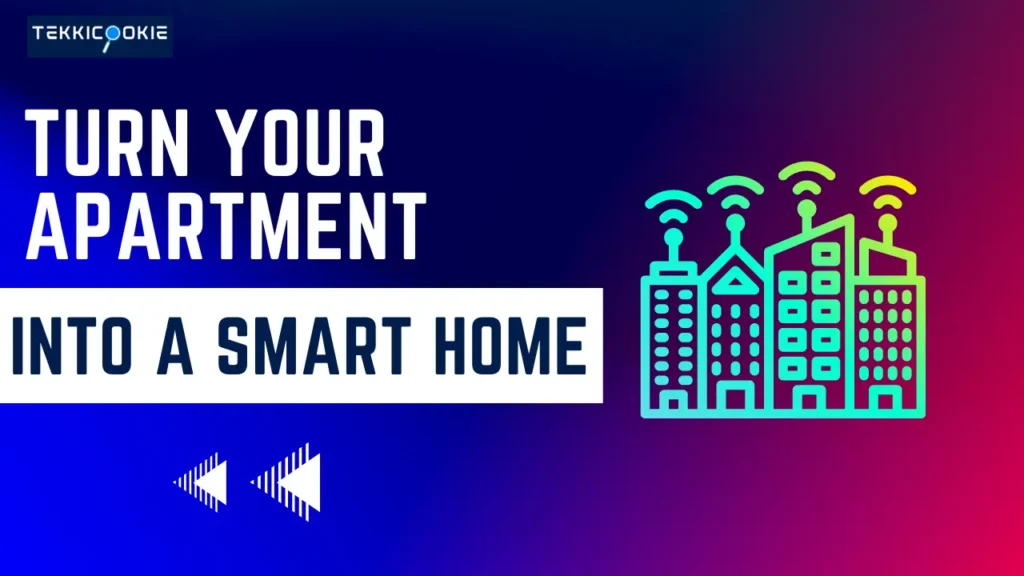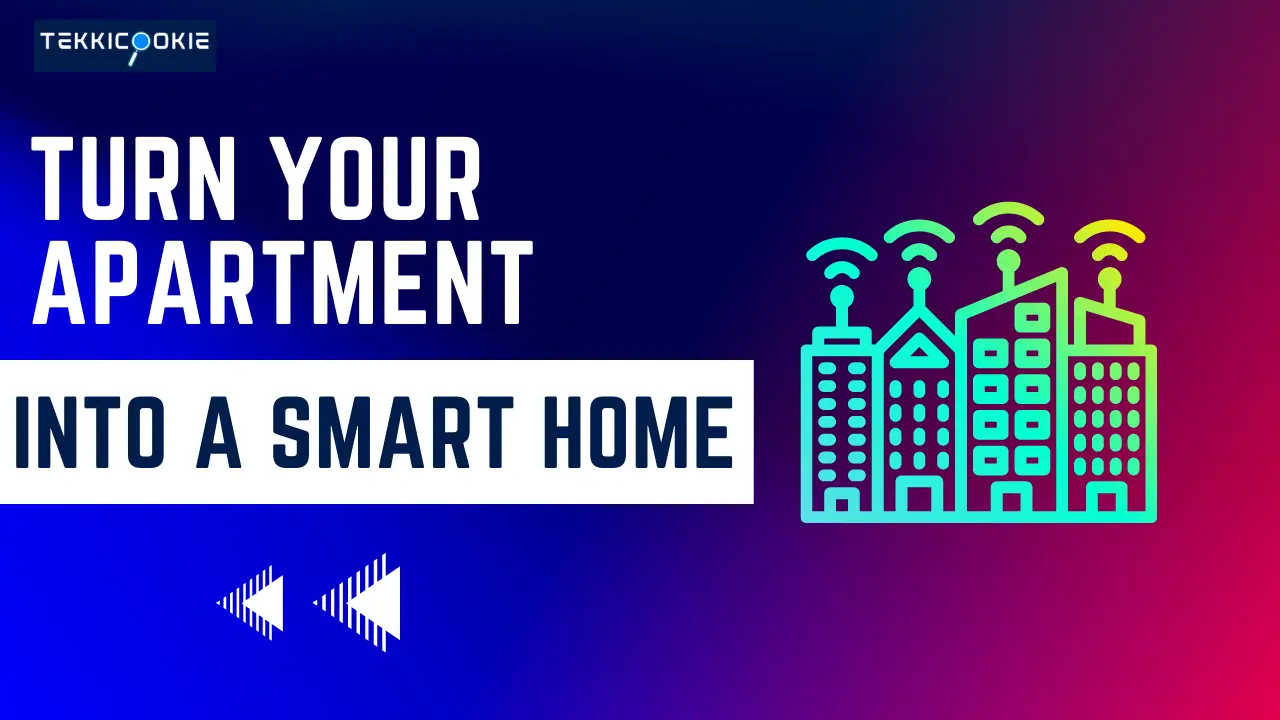In an era driven by technological advancements, the concept of a smart home has gained significant popularity. The ability to control various aspects of your living space with the touch of a button or a simple voice command has revolutionized the way we interact with our homes. But can you transform your apartment into a smart home? Let’s delve into the possibilities and considerations.

Assessing the Apartment
Before embarking on the smart home journey, it’s crucial to assess your apartment’s infrastructure. Start by evaluating the existing electrical system capacity.
Some older buildings may have limitations that could affect the installation and operation of smart devices.
You need to ensure that your apartment’s electrical system can handle the additional power requirements of smart home technology. If needed, consult an electrician to assess the capacity and make any necessary upgrades.
Additionally, check the availability and quality of your internet connectivity, as a stable network connection is essential for smart home functionality.
Ensure that you have a reliable and high-speed internet connection that can support the numerous devices you plan to integrate into your smart home network.
Furthermore, consider any potential limitations imposed by your landlord or property management.
Some rental agreements may restrict modifications to the property, including the installation of new wiring or drilling holes for devices.
It’s important to familiarize yourself with the terms and conditions of your lease to determine what is allowed within your apartment.
If you encounter restrictions, communicate with your landlord or property manager to seek permission and explore potential alternatives.
Key Components of a Smart Home
1. Smart Lighting
Smart lighting is one of the foundational elements of a smart home. With the ability to control your lights remotely or through voice commands, you can create ambience, save energy, and enhance security.
Smart bulbs, such as Wi-Fi-enabled bulbs or those using other protocols like Zigbee or Z-Wave, allow you to adjust the brightness, colour, and scheduling of your lights.
You can even sync them with other smart devices or set up automation rules to activate specific lighting scenes based on your preferences or time of day.
When installing smart lighting systems, follow the manufacturer’s instructions and safety guidelines.
Most smart bulbs are designed to fit standard light fixtures, making installation a straightforward process.
Once installed, configure the bulbs using the accompanying mobile app or a compatible smart home hub, allowing you to control them individually or as part of a larger lighting system.
2. Home Security
Enhancing the security of your apartment through smart home technology is essential for peace of mind.
Smart locks, doorbell cameras, and security systems provide advanced features that offer convenience and protection.
Smart locks allow you to remotely lock or unlock your doors, grant access to visitors, and receive notifications when someone enters or exits your apartment.
Doorbell cameras provide real-time video feeds and motion detection alerts, allowing you to see who is at your door from anywhere using your smartphone.
Integrating a comprehensive security system with motion sensors and surveillance cameras further enhances your apartment’s safety by providing an extra layer of protection and alerts in case of any unusual activity.
3. Energy Management
Efficient energy management is not only environmentally friendly but can also help reduce utility bills.
Smart home technology provides tools to monitor and control energy consumption, allowing you to make informed decisions about energy-saving practices.
Smart thermostats are key components of energy management in a smart home. These devices enable you to remotely control your apartment’s temperature, set schedules and even learn your heating and cooling preferences over time.
By adjusting the temperature when you’re away or optimizing it based on occupancy, smart thermostats help save energy and create a comfortable living environment.
In addition to smart thermostats, consider integrating energy-efficient appliances and smart plugs into your apartment.
Energy-efficient appliances, such as smart refrigerators, washing machines, or dishwashers, are designed to reduce energy consumption without compromising performance.
Smart plugs, on the other hand, allow you to control the power supply to devices that are plugged into them, enabling you to turn off appliances when not in use or schedule them to operate during off-peak hours.
4. Entertainment and Media
Transforming your apartment into a smart home extends beyond practicality and security—it also encompasses entertainment and media experiences.
With smart TVs, streaming devices, and voice-controlled virtual assistants, you can enjoy seamless access to your favourite content and create a connected entertainment ecosystem.
Smart TVs and streaming devices, such as Apple TV, Amazon Fire TV, or Google Chromecast, enable you to stream movies, TV shows, and music from popular platforms like Netflix, Hulu, or Spotify.
Many smart TVs are equipped with voice control capabilities, allowing you to search for content, adjust settings, and navigate menus using simple voice commands.
Virtual assistants like Amazon Alexa or Google Assistant play a central role in the smart home entertainment experience.
By integrating them with your smart TV, speakers, and other compatible devices, you can control your entire entertainment system with your voice.
From playing music to adjusting volume levels or even dimming the lights, virtual assistants provide a hands-free and immersive experience.
5. Home Automation
Home automation ties all the components of a smart home together, allowing you to create personalized routines and schedules that fit your lifestyle.
By integrating various smart devices and sensors, you can orchestrate a seamless experience that adapts to your needs and preferences.
Create custom routines that activate specific actions when triggered by certain events or at predetermined times.
For example, you can configure your smart lighting to gradually brighten in the morning, your smart thermostat to adjust the temperature when you wake up, and your favourite music to start playing in sync with your morning routine.
To streamline the management of your smart home, consider using a smart home hub or virtual assistant as a central control point.
These devices act as a command centre, allowing you to control multiple smart devices with a single voice command or through a mobile app.
Overcoming Challenges
While the idea of a smart home apartment is enticing, certain challenges may arise when attempting to implement this technology.
However, with proper planning and innovative solutions, you can overcome these challenges and create a smart home experience tailored to your needs.
1. Working within Landlord Restrictions
If you’re a renter, it’s crucial to respect the rules and regulations set by your landlord or property management.
Before making any modifications to your apartment, seek permission and communicate your intentions.
Explain the benefits of smart home technology, such as enhanced security, energy efficiency, and convenience.
Some landlords may be open to allowing certain smart devices or temporary installations that can be easily removed when you move out.
In cases where permanent alterations are not allowed, temporary solutions can provide a taste of smart home convenience without violating any terms.
For example, smart plugs can be used to control lamps or small appliances, while wireless smart home systems can be easily installed and uninstalled without leaving a trace.
2. Addressing Budget Constraints
Budget constraints can be a significant factor when considering the transformation of your apartment into a smart home.
However, with careful planning and prioritization, you can make smart choices that align with your financial resources.
Start by prioritizing the essential components based on your needs and preferences. Focus on devices that have the most significant impact on your daily life, such as smart lighting or security systems.
By starting with a few key devices, you can gradually expand your smart home ecosystem over time.
Consider cost-effective options and research affordable yet reliable brands. Look for sales, discounts, or refurbished options to save money without compromising quality. Additionally, explore do-it-yourself installation options to avoid additional expenses related to professional assistance.
Read More: How Do I Convert My Normal Home To a Smart Home?
Setting Up Your Smart Home
To successfully set up your smart home, it’s crucial to conduct thorough research and select compatible devices that meet your requirements.
Consider factors like device compatibility with your existing infrastructure and the reliability of the brand or manufacturer.
Start by creating a list of the devices you want to incorporate into your smart home ecosystem, such as smart locks, lighting systems, thermostats, and entertainment devices.
Research different brands and models, reading reviews and comparing features to make informed decisions.
Once you’ve acquired the desired devices, the installation and configuration processes can vary.
Some devices may be suitable for DIY installation, while others may require professional assistance, especially if they involve complex wiring or network setup.
Ensure that you carefully follow the manufacturer’s instructions for each device, connecting them to your home network and configuring them using device-specific applications or a central smart home hub.
Ensuring Privacy and Security
As with any connected technology, privacy and security are paramount when it comes to smart homes.
With multiple devices interconnected and potentially collecting personal data, it’s essential to implement robust security practices to protect your information and maintain your privacy.
Start by securing your Wi-Fi network with a strong, unique password. Avoid using default passwords and opt for a combination of letters, numbers, and special characters.
Enable two-factor authentication whenever possible to add an extra layer of security to your smart home network.
Regularly update your device firmware to ensure you have the latest security patches and bug fixes.
Manufacturers often release updates to address vulnerabilities, so it’s crucial to stay up to date to protect your devices from potential threats.
Furthermore, be mindful of data privacy concerns associated with smart home devices.
Read and understand the data collection practices of the devices you use, ensuring that your personal information is handled responsibly and transparently.
Look for devices and manufacturers that prioritize privacy and provide clear data handling policies.
Troubleshooting and Maintenance
While smart home technology offers convenience and efficiency, occasional issues may arise.
It’s important to be prepared to troubleshoot common problems and perform regular maintenance to keep your smart home running smoothly.
Start by familiarizing yourself with the support resources provided by the device manufacturers.
User manuals, troubleshooting guides, and online support forums can provide valuable insights into addressing common issues and finding solutions.
Engaging with online communities of smart home enthusiasts can also provide helpful tips and recommendations based on their experiences.
Regularly update the firmware of your devices to ensure you have access to the latest features, bug fixes, and security patches. Set up notifications or reminders to prompt you to check for updates periodically.
Conclusion
Transforming your apartment into a smart home is indeed feasible and can enhance your living experience in numerous ways.
From the convenience of controlling lighting and security to the efficiency of energy management and immersive entertainment and media experiences, the possibilities are vast.
By carefully assessing your apartment’s infrastructure, selecting suitable devices, and addressing any challenges, you can create a personalized smart home that aligns with your needs and preferences.
Embrace the journey of transforming your apartment into a smart haven and enjoy the benefits it brings to your daily life.
With proper planning, smart choices, and a touch of technological innovation, you can turn your apartment into a smart home that offers convenience, security, energy efficiency, and a futuristic living experience.
Hey there, folks! If you have liked the article then don’t forget to give us a follow on our social media channels below. That way, you’ll be the first to know about all the exciting updates!
